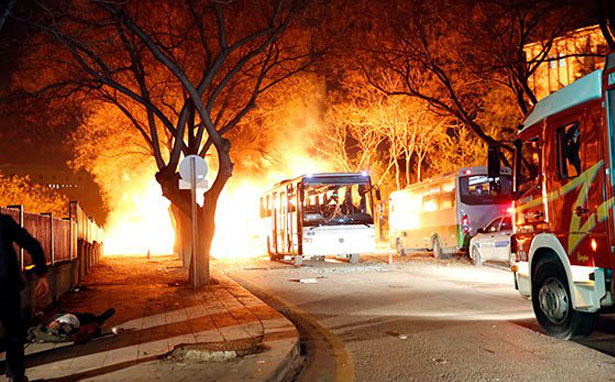An attack on a shuttle carrying military personnel in Ankara has come at a time in which the AKP has been experiencing a crisis due to its bellicose policies on the Kurdish issue and growing dissent within its ranks, as well as isolation on its Syrian policies The government of Prime Minister Ahmet Davutoğlu was […]

An attack on a shuttle carrying military personnel in Ankara has come at a time in which the AKP has been experiencing a crisis due to its bellicose policies on the Kurdish issue and growing dissent within its ranks, as well as isolation on its Syrian policies
The government of Prime Minister Ahmet Davutoğlu was quick to pin the blame for a Feb. 17 bomb attack in Ankara that killed 28 and injured 61 more on the People’s Protection Units (YPG) as part of its recent attacks on the group.
But amid the forecasts of the ramifications of the attack, taking a closer look at the developments prior to the attack is beneficial for understanding how Turkey has come to find itself on the edge of the precipice.
The assault on the military personnel has come at a time in which the ruling Justice and Development Party (AKP) has been experiencing a crisis due to its bellicose policies on the Kurdish issue and growing dissent within its ranks, as well as isolation on its Syrian policies.
In just the last 20 days, the following has occurred during the war in the country’s Kurdish province, as well as the brutal conflict in Syria:
Davutoğlu, several ministers, Chief of General Staff Gen. Hulusi Akar and National Intelligence Organization (MİT) Undersecretary Hakan Fidan traveled to Saudi Arabia on 31 January and 1 February during a critical period in which jihadists had lost ground to the Syrian Army and its allies acting with Russian support, as well as amid fierce arguments about who could be represented in talks in Geneva about the future of Syria.
On 1 February, the Syrian Army and its allies acting with Russian support launched an operation on Aleppo, cutting off the last supply line from Turkey to jihadist defenders on 3 February.
The Syrian Army and the People’s Protection Units/Women’s Protection Units (YPG/YPJ) began a coordinated operation with Russian air support along the Azez-Tel Rifaat-Marea front against cornered jihadist forces backed by the AKP on 4 February.
Faced with the prospect of losing its presence in the fight with the closing of the supply line to Aleppo, the AKP ordered Turkish forces to increase their activity along the border, with AKP spokesman Ömer Çelik attempting on 4 February to justify the actions by invoking Turkey’s sensitivities in terms of its “red lines” stemming from the Tishrin Operation in late December 2015.
After failing to reach its desired outcomes, Turkey’s government introduced its 10-point “Master Plan on 5 February.
At least 150 people were killed in a massacre in three basements in the southeastern district of Cizre on 7 February. The number of those killed came in excess of the close to 80 that had already been killed in a two-month-long siege by government forces in the districts of Sur, Cizre and Silopi.
Returning from a Latin America trip on 7 February, President Recep Tayyip Erdoğan noted that Turkey “did not want to make the same mistake as it did in 2003, when parliamentarians refused to send Turkish troops into Iraq during the U.S. invasion. Erdoğan also asked Washington whether Turkey or the “terrorists in Kobane” were the U.S.’ ally.
Hürriyet journalist Deniz Zeyrek reported on 10 February that “military sources” had said that “Turkish troops would not step foot on Syrian soil without a decision from the U.N. Security Council.” “A senior official” also said Turkey’s military would not take part in any alliance called the “Army of Islam” in a message highlighting the military’s discomfort with a possible invasion with Saudi Arabia in Syria.
Syrian Democratic Forces (QSD) acting under the leadership of the YPG/YPJ took control of the Minnağ (Minîh) Military Airbase and Minîh village to the south of Azez on 11 February.
Turkish military forces began firing artillery rounds on 13 February at the YPG/YPJ stationed at the Minnağ Airbase, as well as the villages of Minîh and Merinaz, as they advanced north toward Azez. Pro-AKP media initially reported the attacks as a “direct intervention” before reporting that the Turkish military had “responded within the rules of engagement.”
Davutoğlu demanded that the YPG immediately withdraw from Azez and its vicinity, but Democratic Union Party (PYD) leader Salih Muslim said the group had no plans to withdraw from the area.
Referring to the U.S., Davutoğlu called on “friendly and allied countries” on 13 February to adopt Turkey’s stance on the PYD and the YPG, noting that “we will not hesitate to take the necessary steps in Syria that we take in Kandil [in bombing PKK positions].”
Davutoğlu claimed that the YPG/YPJ and QSD’s advance on Azez had been halted, but the forces continued to advance on 15 and 16 February.
With international pressure growing on Turkey to cease its attacks on Syria, the AKP government intensified its rhetoric regarding the ties between the “terrorist organizations” of the PYD and the PKK, proclaiming that “a land operation could be necessary.”
News emerged on 17 February of the possibility of a massacre in Diyarbakır’s Sur district that would mirror the killings in Cizre, as Dicle News Agency (DİHA) journalist Mazlum Dolan texted that up to 200 people were marooned in a building and facing death at the hands of Turkish government forces.
Sendika.Org